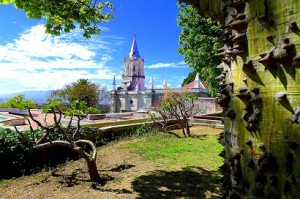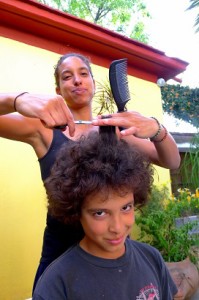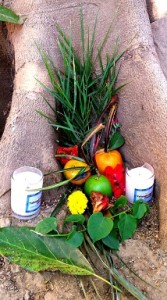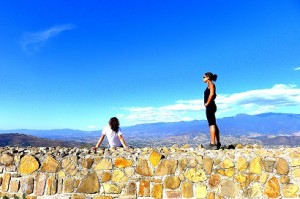 “El corazón de nuestra madre tierra vive en el espíritu de nuestros pueblos.”
“El corazón de nuestra madre tierra vive en el espíritu de nuestros pueblos.”
The heart of our mother earth lives in the spirit of our [rural] communities.
~Declaration of CNI and EZLN August 2013
We love our temporarily urban life – commuting miles on foot, tasting popsicles made of cactus apples from street vendors, and learning the unique horn sounds of the passing vehicles and vendors. (E.g. The cow mooing sound is the propane vendor and the bell is the trash collector.) That said, we find our hearts are still in the pueblos and feel a spacious sense of belonging in visiting the farmers and arti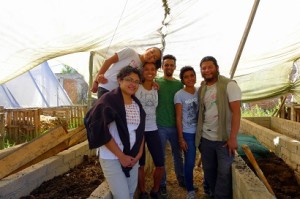 sans in the small valley towns of Oaxaca.
sans in the small valley towns of Oaxaca.
Last week, we visited Teotitlán del Valle to connect with the Vida Nueva weaving cooperative. This powerful group of women create intricate weavings using wool and all natural plant dyes and have achieved economic self-sufficiency and community respect, despite strong initial resistance to female entrepreneurship. We talked with Pastora, who explained that the cooperative also uses its resources to coordinate a community project each year – from reforestation to composting toilets. When we asked whether she could teach Neshima how to weave, she explained that the community has guidelines that only children born into the pueblo learn the art. This is how they preserve their tradition, which extends back to pre-Hispanic generations.
Northwest of Oaxaca City lies the lush pueblo of San Agustín Etla. We did not fully appreciate how dry the land is around our home until we experienced the contrast of flowing streams and turgid greenery. In Etla we explored the hillside gardens of elder, Doña Maria, who was teaching a workshop on growing oyster mushrooms. There we met our kindred farming nerds, Lupe and Fredy, who invited us down to their micro-farm. We spent a couple of hours discussing their intercropping of tomatoes and garbanzo, best methods for increasing soil micronutrients, and long-term greenhouse management. Deliciously geeky! They are teaching a workshop on biointensive farming next month and Leah, hands aching with the desire to hold a shovel, offered to help dig the beds.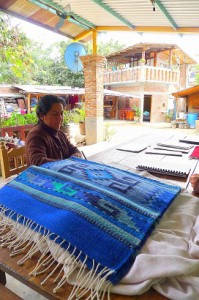
This past weekend, we visited one of the oldest cities in Mesoamerica, Monte Alban. Inhabited between 500 BCE and 1521 AD, and once home to over 17,000 people, this mountaintop city renders its visitors silent with its grandeur. The central plaza is 1000 feet in length and completely level. The stone structures tower into the sky and yet, align with the stars. There is no hilltop water and somehow the population endured.
We then ventured south to connect with farmers in San Bartolo Coyotepec, who raise the nopal 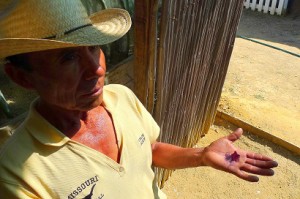 cactus, or more precisely – the little insect that drinks the nopal’s juices. The tiny cuchinilla, when squished, reveals a deep crimson that is used to make natural coloring in textiles, shampoos, even food. (Yes, there are bugs in your strawberry yogurt.) Farmer Vicente explained in detail the life cycle of the cuchinilla, its preference for partial shade, the subtle color differences when raised on live cactus versus harvested leaves, and the methods for refining the dye. The kids were less fascinated, and played tic tac toe with a stick, in the shade of a tree on the dirt road.
cactus, or more precisely – the little insect that drinks the nopal’s juices. The tiny cuchinilla, when squished, reveals a deep crimson that is used to make natural coloring in textiles, shampoos, even food. (Yes, there are bugs in your strawberry yogurt.) Farmer Vicente explained in detail the life cycle of the cuchinilla, its preference for partial shade, the subtle color differences when raised on live cactus versus harvested leaves, and the methods for refining the dye. The kids were less fascinated, and played tic tac toe with a stick, in the shade of a tree on the dirt road.
Vicente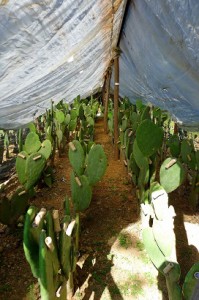 was just a few blocks from the artisan market where the pueblo’s famous black pottery (barro negro) is sold. We lingered in the stall of Magali, whose kind eyes, long dark braids welcomed us to chat. She was patient with our questions and decided to show us how to mold and carve the clay into a simple turtle and a more intricate decorative pot. Incredibly, they have developed a technology using two rounded plates as a potters wheel, allowing for the creation of large and perfectly symmetrical work. Neshima and Emet have a date to go to her house next week and learn more. Of Magali’s six children, three are potters. Of this, she is proud. Emet had a breakthrough while spending time with these artists. Prior to this trip, in fact for several years, he has only wanted to spend his money on Legos and only ever
was just a few blocks from the artisan market where the pueblo’s famous black pottery (barro negro) is sold. We lingered in the stall of Magali, whose kind eyes, long dark braids welcomed us to chat. She was patient with our questions and decided to show us how to mold and carve the clay into a simple turtle and a more intricate decorative pot. Incredibly, they have developed a technology using two rounded plates as a potters wheel, allowing for the creation of large and perfectly symmetrical work. Neshima and Emet have a date to go to her house next week and learn more. Of Magali’s six children, three are potters. Of this, she is proud. Emet had a breakthrough while spending time with these artists. Prior to this trip, in fact for several years, he has only wanted to spend his money on Legos and only ever 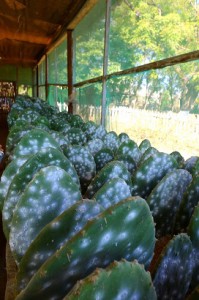 requested Legos as gifts. On that day, he purchased a piece of art with sincere enthusiasm. He said, “It’s just so amazing” and hugged the piece protectively on the taxi ride home.
requested Legos as gifts. On that day, he purchased a piece of art with sincere enthusiasm. He said, “It’s just so amazing” and hugged the piece protectively on the taxi ride home.
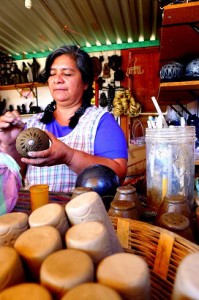 We are starting to build community here in Oaxaca City as well. The kids really miss their friends, and while there can be no replacement – we have reached out to connect them with others their age. Friday night we visited an ex-pat family with daughters who dance on silks and play the violin. It turns out their family moved to Mexico over 5 years ago, intended to just stay for a little while, but have not looked back. They have no pull to return to the insanity of commuting, the capitalist rat race, or the American expectation to move at a pace that precludes human connection. We can’t blame them (but do promise to return to you, at least for a while.) The kids warmed up to each other quickly and went from a tame game of cards to some insane version of dodgeball that left them all red-cheeked and sweaty. We couldn’t get them to leave, so had to promise a joint family camping and hiking adventure in the upcoming weeks.
We are starting to build community here in Oaxaca City as well. The kids really miss their friends, and while there can be no replacement – we have reached out to connect them with others their age. Friday night we visited an ex-pat family with daughters who dance on silks and play the violin. It turns out their family moved to Mexico over 5 years ago, intended to just stay for a little while, but have not looked back. They have no pull to return to the insanity of commuting, the capitalist rat race, or the American expectation to move at a pace that precludes human connection. We can’t blame them (but do promise to return to you, at least for a while.) The kids warmed up to each other quickly and went from a tame game of cards to some insane version of dodgeball that left them all red-cheeked and sweaty. We couldn’t get them to leave, so had to promise a joint family camping and hiking adventure in the upcoming weeks.
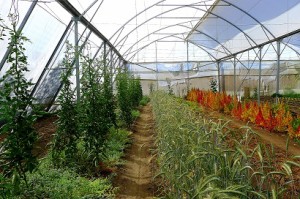 We also connected with fellow activists in our age group – Kiado, Aerin, and Yeyo. Kiado is a Zapotec indigenous man who has written beautiful articles about the inseparability of maize and his people in material and spiritual terms. He divides his time between his family’s cooperative coffee farm in Sierra Norte and his government job in Oaxaca City. Aerin and Yeyo have their hands in just about every project related to justice and sustainability in the region. They narrated a long list of contacts to us over ice cream and then invited us to a super fun collage night where we created bowls and mobiles out of paper, and marvelled at the myriad ways they use reclaimed materials. They gifted us some native seeds of maize, beans, and amaranth that we are excited to cultivate back on the farm.
We also connected with fellow activists in our age group – Kiado, Aerin, and Yeyo. Kiado is a Zapotec indigenous man who has written beautiful articles about the inseparability of maize and his people in material and spiritual terms. He divides his time between his family’s cooperative coffee farm in Sierra Norte and his government job in Oaxaca City. Aerin and Yeyo have their hands in just about every project related to justice and sustainability in the region. They narrated a long list of contacts to us over ice cream and then invited us to a super fun collage night where we created bowls and mobiles out of paper, and marvelled at the myriad ways they use reclaimed materials. They gifted us some native seeds of maize, beans, and amaranth that we are excited to cultivate back on the farm.
We are also building a relationship with Gustavo Esteva at Universidad de la Tierra. This powerful elder is, to quote the director of my department at the university, “The most radical man I have ever met, and also the most committed.” We attended his seminar at Unitierra debriefing the Festival de las Resistencias put on by the EZLN and CNI. Tomorrow we will participate in another seminar, discussing the global revolution currently taking place and how we can be most effective in its actualization. Unitierra has projects all over the valley related to sustainable agriculture and community autonomy. We offered to help with those initiatives as well. If all of our offers are accepted, we may get busy.
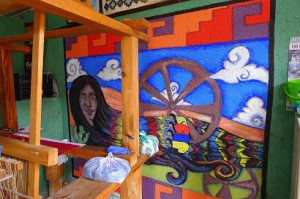 In the meantime, our life has just enough spaciousness. We take our time in the park, Jonah leading writing exercises for the children as part of their homeschooling. We take our time to Skype with friends and family back home, to journal, to watch and discuss a film in honor of MLK Day. We take time to hug big trees and look into the eyes of a passing praying mantis. We have time to make a torch out of an egg crate, to laugh until our bellies hurt, to see what happens when you fry a corn flower in garbanzo meal. It’s real different, real special.
In the meantime, our life has just enough spaciousness. We take our time in the park, Jonah leading writing exercises for the children as part of their homeschooling. We take our time to Skype with friends and family back home, to journal, to watch and discuss a film in honor of MLK Day. We take time to hug big trees and look into the eyes of a passing praying mantis. We have time to make a torch out of an egg crate, to laugh until our bellies hurt, to see what happens when you fry a corn flower in garbanzo meal. It’s real different, real special.
We are so grateful for our dear ones in the movement who have been collaborating with us from afar. Dear Naima and Beatrice, who just returned from a planning delegation in Haiti honoring the 5th anniversary of the earthquake with ceremony, community run, and collective art making. They are laying the foundation for a powerful delegation of Ayiti Resurrect this spring – which we will attend. We are grateful for Jalal Sabur, Jillian Faison, Carmen Duncan, Karen Washington, Malik Yakini, Dr. Monica White, and LaDonna Sanders – who talked with Leah about the intersection of #BlackLivesMatter and Food Sovereignty so she could write an article on the topic for YES! Magazine. The article comes out next week! The writing process has been a connecting process and actually resulted in some new collaborations in the movement to abolish the racial caste system that devalues black lives.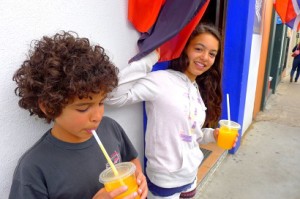
We are only including some select photos from the past two weeks, but are sharing many more here.
Oh, we hear a bicycle horn! If we are interpreting correctly, that means ice cream. Gotta get some!

